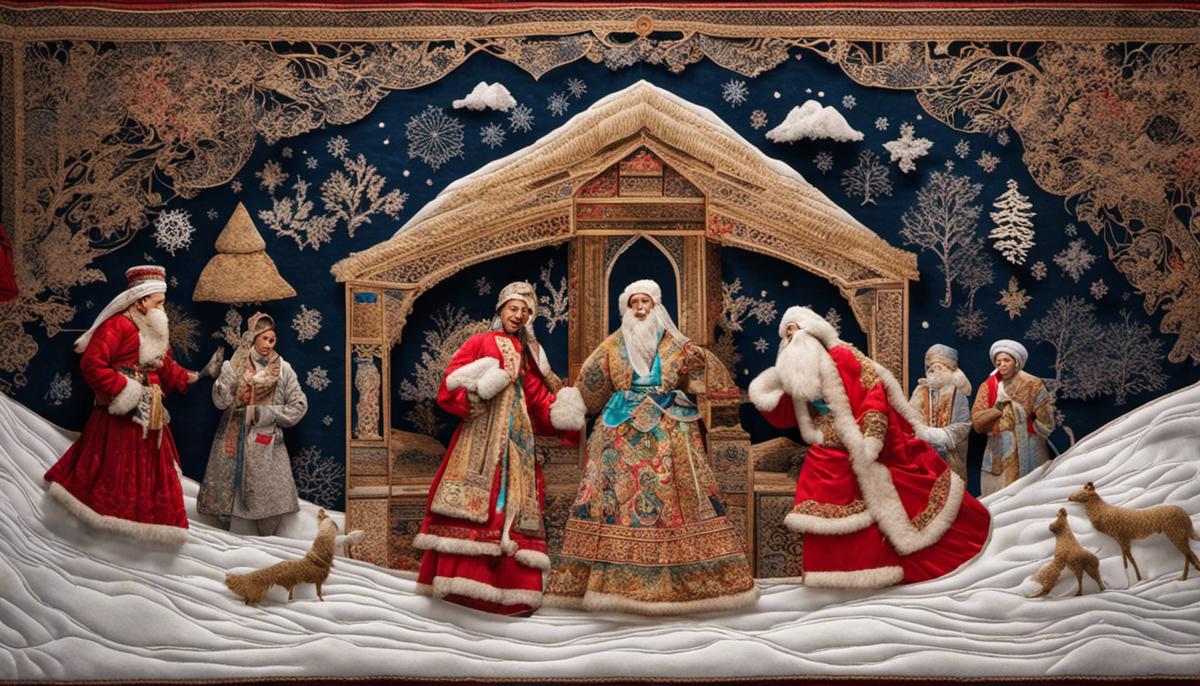As winter breezes paint the landscape in a stunning white, the artistry and science of winter fabrics gain prominence. This rich narrative weaves together the historical, the functional, and the expressive elements of textiles designed to challenge the frigid cold. Journeying from the vibrant tapestry of different civilizations’ fabric traditions to the gallery of fabric types—each with its own merits and shortcomings—we explore how craftsmanship and technology meet in this symphony of winter textiles. Be it the ancient wools of Nordic tribes, the soft furs of the Inuits, or the modern synthetic creations of fleece and thinsulate, each fabric narrates a unique story of comfort, survival, and aesthetic appeal.
Table of Contents
Historical and Cultural Significance of Winter Fabrics
The Tapestry of Warmth: The Role of Fabrics in Cultures’ Winter Reactions
As the chilly winter season unfurls, one cannot help but marvel at the creative genius that different cultures exhibit in response. Rather remarkably, materials like fabrics have played a considerable role in helping communities acclimate to the ice-cold months. They do so by harnessing artistic creativity and pragmatic fortitude, creating a symphony of warmth and beauty that keeps winter at bay.
Let’s embark on an exploration of some cultures that have managed to knit their artistic creativity and fabrics into a shield against the frosty onslaught of winter.
The intricate fabric art of the Sami people from the Arctic Circle is nothing short of a spectacle. They’re experts in the “gákti,” a traditional costume mainly made from wool, adorned with bands of silken thread, tin, and even reindeer leather. The colors and patterns are not purely aesthetic – they depict the wearer’s marital status, geographical location, and even the specific occasion. Amidst the stark white snow, these flamboyant fabrics become a striking canvas of cultural expression and a crucial barrier against the biting cold.
A glance towards Japan, and here we see the delightful art of “boro.” Boro is straight out of a scene from a patchwork quilt lover’s dream, with its assembly of scrap pieces of cotton dyed with indigo. More than just an artistic trend, it was born of necessity among the peasant classes of Japan to protect against the cold. Today, they signify a beautiful coming together of sustainability and utility.
As we move to colder regions, like Siberia, the brilliant art of fur takes precedence. Indigenous Siberian communities have long mastered the art of fur clothing to keep the winter chill at bay. From the long and flowing “Kulatak” jackets of the Nanai people to the ornately decorated “Yagushka” fur coats of the Khanty community, the use of fur is a testament to both survival and craft.
From the Middle East comes the “Aba,” a simple overgarment made from wool or camel hair. Weaving these fabrics into symbolism-filled motifs and intricate designs, these desert people transformed the simplicity of the material into a vibrant canvas of expression, providing much-needed warmth during the frosty desert nights.
Venturing over to India, the art of “Pashmina” shawls from Kashmir is worthy of mention. Derived from a breed of Himalayan goats, these luxuriously soft shawls are pieces of warmth and exquisite beauty, occupying a treasured space in every fashion lover’s wardrobe.
Each stroke on the canvas that is our world’s communities provides us a picture that’s enriching and varied – a veritable tapestry of warmth created by cultures responding to winter. The fabrics, through the hands of generations of skillful artisans, not only combat the cold but echo the communities’ rich histories and narratives. This innate human ability to transform humble fabrics into illustrious pieces of warmth and creativity is indeed worth admiring and treasuring. As the temperature dips and winter unfurls its icy tendrils, we shall wrap ourselves in these rich histories and continue celebrating the vibrant artistry and warmth of our worldwide cultural quilt.

Understanding the Pros and Cons Different Fabric Types
Unraveling the Winter Fabric Secret: Understanding Yarn and Weave Configuration
Juxtaposing diverse perspective from the spectrum of art and science, there’s a delicate dance that occurs between the threads of winter fabrics, a harmonious interplay that culminates into a comfy, cozy symphony. Diving into fabrics optimally designed for winter weather, certain characteristics take center stage, dictating which textiles are more suitable for warding off arctic air.
Delight in Density: More threads, more warmth. Winter fabrics typically have a high thread count or dense weave, forming the front line of defense against piercing winds. Twill, a type of weave with a pattern of diagonal parallel ribs, is a notable example. Imagine an array of zigzagging threads, generating a robust fabric perfect for blustery conditions. Unwrapping the science behind this, it’s the dense network of threads that effectively traps body heat, forming a warm microclimate right next to the skin.
The Power of Piling: Similar to how multiple layers of paint or varnish add depth and richness to a masterpiece, certain fabrics take advantage of piling to up their cozy game. A classic example, fleece, is renowned for its insulating quality. In the scene of textile art, fleece stands as a sculpted canvas, adding intricate detail and depth to winter wear. However, its practical advantage lies in the tiny air pockets created between the piles that diligently retain warmth.
The Wonder of Wool: Winter wear would be incomplete without mentioning the significance of wool. Its crimped structure creates a voluminous network with abundant air spaces, forming a highly effective thermal insulator. More so, wool is a great absorber of moisture, keeping the wearer dry and comfortable. Its utilization spans centuries and cultures, morphing into various artistic and functional forms – From vibrant Icelandic sweaters to elegant Scottish tartan, wool eases into the heart of winter fabrics, merging style, comfort, and warmth.
Exploring Embellishments: Where details meet intention, the result is a beautiful amalgamation of form and function. Winter fabrics often employ quilting or embedding fur or other insulating materials between fabric layers. This acts as added armor against the cold while simultaneously providing a canvas for artists to express meaningful narratives.
Charting the Coating: Various winter fabrics also utilize a special coating technique to guard against moisture. The outer layer is often treated with durable water repellent (DWR), which allows the fabric to remain breathable while keeping icy drizzles at bay.
Winter fabrics thus unravel a riveting tale of how human innovation intersects with the raw prowess of nature. They are where the practicality of science meets the passion of artistic expression, the intersection of comfort, style, and winter resilience. Examining them more closely, you can’t help but marvel at the intricacy and intention hidden between the threads – a quiet reminder of the beautiful harmony that exists when art and ingenuity come together. As winter’s spell descends, these fabrics encapsulate a warm embrace, combining thoughtful design and enchanting narratives to combat the cold.

Artistic and Practical Applications of Winter Fabrics
“Density Defines Warmth”
Resilience against the cold is exuded through high thread count, densely woven winter fabrics. Withstanding arctic blasts, these plush materials hold the secrets of warmth and comfort. The thickly meshed fibers at microscopic level manifest properties retaining body heat, and therefore, combating cold more efficiently than loosely woven ones. Think of cozy knit sweaters, warm flannel shirts or the double layered down coats using these tight weaves – all practical winter staples that effectively utilize the warmth-keeping benefits of dense fibers.
“Embrace the Piling Phenomenon”
While piling on fabrics can be seen as a nuisance in some cases, winter fabrics embrace this to create snug comfort. Prioritized in fuzzy materials like fleece and flannel, the piling effect creates microscopic voids that trap warm air, enhancing the insulation of the fabric. Not only do these pillings promote warmth, they add a textural element to winter fabric crafts, acquiring a plush, cozy aesthetic that appeals to comfort seekers and fashion enthusiasts alike.
“Wandering in Wool’s Wonders”
The treasure of cold-climate sheep, wool, has been the guardian against biting cold winds for centuries. It’s a natural insulator, with fibers creating tiny air pockets that trap heat. Furthermore, its inherent capacity for moisture absorption keeps the wearer dry and warm. Not only is it practically resourceful, wool has a rich tapestry across a spectrum of crafts – knitted scarves, embellished mittens, vibrant felt artworks. It’s a fabric that is both an artist’s dream and a winter warrior’s necessity.
“Lavish Layering – The Art of Embellishing”
Beyond their simplistic use, quilts, furs and other similar insulating materials offer a plethora of creative possibilities. From adding a stylish fur collar or cuffs to a winter coat to designing an eclectic mural of textures and colors through quilting, the embellishments on winter fabrics tap into both functionality and artistry. The extra layers these materials add enhance the garment’s insulation while creating bespoke fashion statements or unique artistic expressions.
“Coat with Craft – Resistance Through DWR”
In the face of wet, snowy winters, winter fabrics use the shield of durable water repellent (DWR) coatings. This technology involves a layering of hydrophobic chemicals to repel water while allowing the fabric to breathe, crucial in maintaining warmth. Apart from its protective role, DWR application opens up new vistas of artistic exploration in terms of experimenting with fabric treatments or creating unique water-resistant design elements.
“A Confluence of Art and Science”
Masterful use of winter fabrics lies at the intersection of art and science, where the knowledge of materials and thermal properties meets the imaginative world of color, texture, and design. As much as the clothes must shelter the wearer, the fabric should also tell a tale. Each stitch, each layer can house a robust narrative, making every drape a dialogue between the creator and the observer.
“Symphony in Style and Substance”
How does one find the perfect triad of comfort, style, and winter resilience? An in-depth understanding of winter fabrics and their potential can guide creators to handpick fabrics and techniques for the desired effect. Whether it’s the warmth of a chunky cashmere scarf, the timeless elegance of a wool coat or the edgy coolness of a DWR treated parka, the tools for winter readiness and style expression lie in the fibers of the fabrics themselves.
Ultimately, winter fabrics serve as a canvas for the intricate dance of purpose and creativity. Every choice in fabric type and treatment holds the potential to both withstand the cold and tell a rich story. After all, is there greater beauty than finding art and utility harmoniously interwoven in the depths of winter?

The world of winter fabrics is an arena where history, science, and art combine to create a spectrum rich in form and function. It illuminates the trials and creative triumphs of mankind – from surviving extreme winter weather to creating beautiful and practical artifacts. An understanding of the different types of winter fabrics, their strengths and drawbacks is, thus, essential not only for practical warmth but also for the enrichment of our own creative pursuits. As we manipulate these materials to craft tapestries, beanies, or innovative wall arts, we are influencing the doctrine of comfort and beauty. So, as the chill grips the air, let us find solace and expression in these textiles, each a testament to human innovation and artistic expression in the face of nature’s severity.

Zara Desertrose is an acclaimed fashion and lifestyle journalist with a Master’s in Fashion and Luxury Marketing. Known for her keen eye for style and cultural trends, Zara’s writing elegantly weaves together the latest fashion movements with lifestyle aesthetics. Her insightful critiques and trend forecasts make her a leading voice for anyone looking to stay at the vanguard of style.

